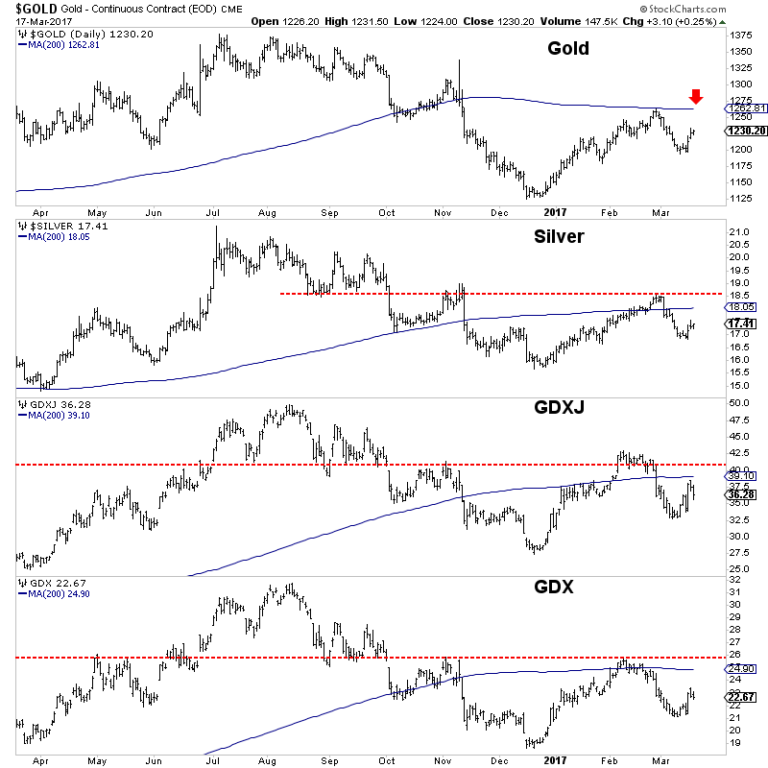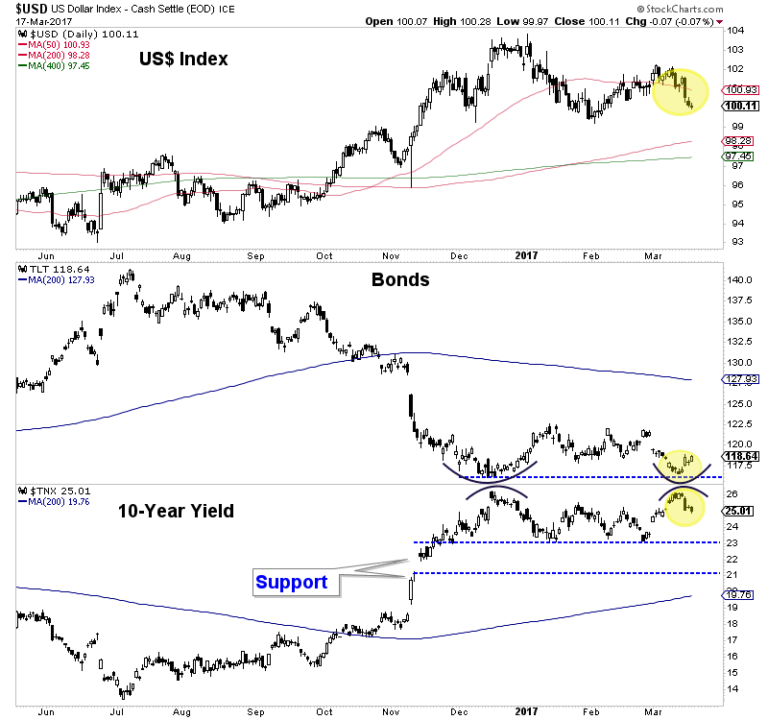Gold & Precious Metals
James Turk – Mega Cup And Handle Formation Has Silver Price Set To Explode Higher
Posted by King World News
on Tuesday, 21 March 2017 14:17
 A Turn May Finally Be At Hand
A Turn May Finally Be At Hand
James Turk: “I’d like to begin, Eric, by noting that based on their Comex closing price in New York, spot gold and silver last week rose by a spectacular $29.10 and 49.6 cents, for gains of 2.2% and 2.9% respectively. Jumps of this magnitude over such a short period of time are rare, so these results from last week are important events that deserve our attention…
…also from King World:
ALERT: Big Money Just Made A Massive Short Bet Against The U.S. Stock Market

Precious Metals and 200-Day Moving Averages
Posted by Jordan Roy-Byrne - The Daily Gold
on Monday, 20 March 2017 14:07
The precious metals complex enjoyed a strong week mostly due to a post-Fed explosion on Wednesday. Although gold stocks sold off to end the week, they finished up almost 5% for the week. Gold gained 2.4% on the week while Silver gained 2.9%. The miners enjoyed massive gains following the previous two rate hikes and that has some optimistic about a repeat scenario. However, the miners and metals need to prove they can recapture their 200-day moving averages before we become optimistic.
Precious metals should trend higher in the short-term if the current macro technical landscape does not change. The US Dollar index has fallen below its 50-day moving average and could fall another 2% to moving average support. Also, despite the Fed rate hike, the 10-year yield did not make a new high. Bonds could rebound and the huge speculative short position, if unwound could add to the rebound. A rally in Bonds coupled with a weak US Dollar would help precious metals.
Precious metals could rebound farther but resistance in the form of the 200-day moving average looms large. In the chart below we plot Gold, Silver, GDXJ and GDX along with their 200-day moving averages. In addition to the 200-day moving average, the February highs will also provide resistance. We should note, while the metals remained above their late January lows, the miners did not. It would not be a good sign to see a continued rally led by the metals rather than the miners.

We should see some upside follow through in precious metals if our read on the US Dollar and Bonds is correct but take note of February highs and 200-day moving averages as resistance. I would not be chasing any strength until the sector proves itself. The first step would be a return to the February highs. If this rally fades below those levels then miners are again at risk for a retest of the recent December lows. We continue to look for bargains that we can buy on weakness and hold into 2018.
For professional guidance in riding this new bull market, consider learning more about our premium service including our current favorite junior miners.

Is Silver a Better Value than Gold Right Now?
Posted by JS Kim
on Friday, 17 March 2017 14:09
 Is silver underpriced compared to gold? Let’s take a look at the facts. Silver currently is $17.28 a troy ounce and gold currently is $1225.66 a troy ounce, meaning the gold: silver price ratio is 71:1. Of course these are spot prices, which don’t match up with actual physical prices, so let’s take a look at the prices of real gold and silver, not paper gold and silver.
Is silver underpriced compared to gold? Let’s take a look at the facts. Silver currently is $17.28 a troy ounce and gold currently is $1225.66 a troy ounce, meaning the gold: silver price ratio is 71:1. Of course these are spot prices, which don’t match up with actual physical prices, so let’s take a look at the prices of real gold and silver, not paper gold and silver.
This morning, the lowest price of a 10-oz gold bar I could find on one dealer’s site per 1-oz of gold was $1,251.29. For silver, the lowest price of a 10-oz silver bar per 1-oz of silver was $18.16. This ratio of gold: silver price still is an enormous 69:1, meaning that you can choose to either buy 10 troy ounces of gold, or for the same dollar amount, purchase 690 ounces of silver.
Some people state that Central Bankers don’t care about the price of silver and they only care about controlling the price of gold, but this statement is just flat out wrong, in my opinion. If Central Bankers didn’t care so much about controlling the price of silver, then they wouldn’t flood the market with boatloads of silvers futures contracts to suppress the price of silver as they do with gold, during the periods they create rapid declines in the prices of these two precious metals. Since we know the mechanisms by which they create these waterfall declines in paper markets (as I’ve discussed these mechanisms extensively in the past and provided documented proof with Nanex provided data), there is no argument that Central Bankers are concerned with controlling the price of silver as well as the price of gold.
Most people look at the paper price of silver and if it is falling, they mistakenly believe that physical silver is not a good buy because a falling price means too much supply and not enough demand. The supply and demand assumption is true, but only true of the paper market where hundreds more paper silver weight is traded than actually physically exists. So then people turn to physical silver prices, and if physical silver prices are falling, they assume this also means too much physical supply and not enough demand, and conclude that physical silver is not a good buy either. However, physical silver prices only fall when paper silver prices are raided by bankers, because bankers have set up a false system that ties physical prices to paper prices that works spectacularly well for them for now. However, there will come a time when physical silver prices actually reflect what is happening with physical supply of silver and physical demand of silver versus the supply and demand determinants of paper silver markets.

The parliamentary election in the Netherlands is behind us. What does the outcome imply for the gold market?
Wednesday was a turbulent day. The U.S. central bank hiked its interest rates for the third time during the current tightening cycle, while a general election was held today in the Netherlands. Although usually nobody cares about the Dutch politics, this time was different. This is because the anti-EU Geert Wilders’ Freedom Party has gained in popularity recently, raising concerns over the rise of populism in the West. The elections were believed to be a litmus test of the sentiment in Europe after the Brexit (by the way, yesterday the Queen gave Royal Assent to the Brexit bill, clearing the way for Theresa May to trigger the exit) and before elections in France and Germany this year.
How did the test go? According to preliminary results, Wilders’ party is set only for 20 seats, while the ruling center-right People’s Party for Freedom and Democracy will take 33 of the 150 available parliamentary seats. Christian Democrats and the centrist Democrats 66 will secure 19 each of them, while the Socialist Party is expected to take 14 seats, the same amount as the Green Party and five more than the Labor Party. Hence, Wilders came in the second place and due to the fractured system of proportional representation, he is unlikely to form a ruling coalition.
What do these results mean for the gold market? Well, Wilders’ defeat may be a signal of a reversal in the worldwide populist trend. It does not bode well for Marine Le Pen in the upcoming French elections and it rules out the possibility of a Dutch withdrawal from the European Union. Therefore, the outcome of the Wednesday’s election reduced political uncertainty, which is negative for gold, the ultimate safe haven. However, investors should not forget that the results should strengthen the euro. The rise in the common currency against the U.S. dollar is usually positive for the yellow metal. Indeed, the currency channel prevailed yesterday and the euro was boosted, as well as gold.
….related from Arkadiusz Sieron:

To observers of financial markets it must seem odd that they often behave exactly the opposite to what is expected. Explaining it is also a strange thing too.
Essentially when the US Federal Reserve jawbones a potential move such as a rate hike (for the best part of a year), investor positioning is congruent with the expected outcome – that is to say dollar / equities up an by extension, gold down.
But what happens when they are too successful in leading the markets expectations and the market positioning is too extreme for the expected move. Well you have a heap of investors who are short gold and long the dollar / equities who don’t get the win they expected… that is to say the move is over-priced into the news. As such, those investors – be they speculators in the futures markets or physical buyers who have forestalled their purchases for a hoped for price correction … are vulnerable.
In this environment a little counter-intuitive buying of gold and selling dollar / equities is usually sufficient to frighten them into covering their position. In short, markets end up moving exactly the opposite way to how classic economics would tell us. And the move feeds on itself because of the extreme positioning.
Evidence to support this view is gold’s move over the last few rates increases – the 25 bps increase in December 2015 saw a subsequent 18% rise in gold over the following 3 months. Meanwhile the December 2016 rate rise saw an 8% increase over the next 3 months. Yesterdays rate rise has seen a 2.4% rise in gold so far … and appears to be petering out. What this indicates is that the wonderful ruse by institutions who exploit predictable investor behaviour seems to be running its course.
So where do we go from here – well having been burned by behaving logically, presumably those investors who keep finding themselves “long and wrong” in dollar/equities and “caught short” in gold will be more perspicacious – a posh way of saying more wise and cynical. Ultimately we could just end up not listening at all.
Ross Norman
CEO
Sharps Pixley, London
…related, published prior to rate hike:


-
I know Mike is a very solid investor and respect his opinions very much. So if he says pay attention to this or that - I will.
~ Dale G.
-
I've started managing my own investments so view Michael's site as a one-stop shop from which to get information and perspectives.
~ Dave E.
-
Michael offers easy reading, honest, common sense information that anyone can use in a practical manner.
~ der_al.
-
A sane voice in a scrambled investment world.
~ Ed R.
Inside Edge Pro Contributors

Greg Weldon

Josef Schachter

Tyler Bollhorn

Ryan Irvine

Paul Beattie

Martin Straith

Patrick Ceresna

Mark Leibovit

James Thorne

Victor Adair

